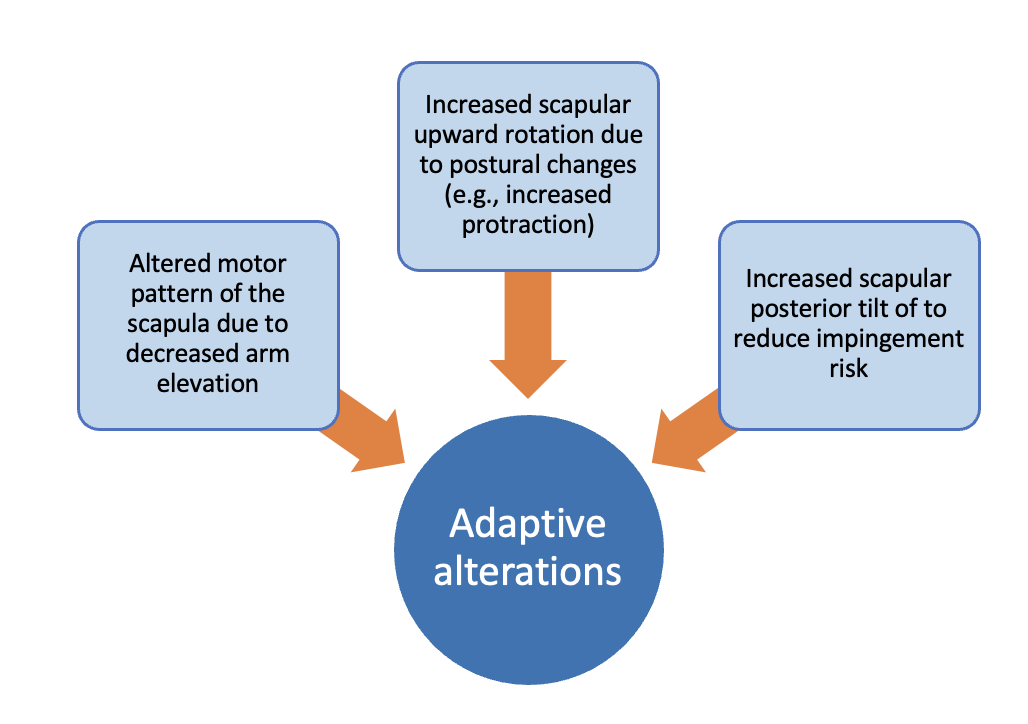Breast cancer is the most frequent cancer among women around the world. Scar tissue formation, fibrosis, and myofascial dysfunction may occur as a result of breast cancer surgery (mastectomy or lumpectomy), axillary surgery (axillary lymph node dissection or sentinel lymph node biopsy), and radiotherapy (1). In the short and long term, these dysfunctions may contribute to upper limb impairments, including altered scapular and/or shoulder kinematics, reduced shoulder range of motion, and decreased muscular strength (2). Unfortunately, these impairments affect 30–84% of breast cancer patients and are associated with a reduction in daily living activities, quality of life, and return to work (3).
Especially in the case of mastectomy, loss of a breast may cause asymmetry in soft tissue motility and mass distribution across the chest wall, which might impact upper limb movements and contribute to trunk or arm symptoms (2). Previous studies found differences in the upward rotation of the scapula in post-mastectomy women who did not have shoulder symptoms (2-4). On the mastectomy side, there is greater scapular upward rotation when compared to the non-affected side. On the other hand, some studies reported a decrease in scapular upward rotation (5,6). When the activity of the upper trapezius and serratus anterior muscles is disrupted, the loss of the scapular upward rotation can be observed. It is speculated that decreased scapular upward rotation can be associated with impingement syndrome or glenohumeral instability (7).
In addition to these alterations, scapulothoracic lateral rotation can be one of the most important kinematic parameters as an indicator for shoulder disorders (7). Increased scapular posterior tilt can be developed due to the loss of the lateral rotation. It is also an adaptation strategy in order to increase subacromial space in the affected extremity of mastectomy patients (7). In addition, inconsistent results were found in terms of scapular posterior tilt (2-5). Patients with breast cancer displayed more scapular posterior tilt on the affected side (3,4). In contrast to these studies, decreased posterior tilt of the scapula was also reported in women with mastectomy who had undergone surgery on their dominant or non-dominant upper extremities (2,5).
The inconsistencies in the articles can be related to the differences in patient populations (age, symptomatic and/or asymptomatic patients), treatment-related factors (surgical procedures, therapy doses), elapsed time since surgery, and measurement procedures. The elapsed time since surgery can be an important parameter for the presence of upper limb impairments. In accordance with current knowledge, upper limb impairments were observed up to six-years post-surgery. It is therefore unclear how long these impairments last (5,6).
|
Despite the differences in the literature, we can understand that women with mastectomy have a greater scapular contribution to the total elevation. This can be related to the adaptation mechanism of dysfunctional glenohumeral movement. If there is stiffness in the glenohumeral joint or dysfunction of the rotator cuff muscle, patients tend to perform greater scapular upward rotation to complete arm elevation (4). Adaptive scapular kinematic changes can be a preventive strategy that has been developed against difficult and pain-related movements (3). |

Figure 1. Possible adaptive alterations of scapular kinematics.
Although there are significant alterations in scapular kinematics on the affected side of women after breast cancer treatment, it is important to realize that this cannot be related to shoulder dysfunction (2). In the very informative blog of Lore Dams, the results of a recent study were summarized. De Baets et al. reported that a non-significant association was observed between humerothoracic elevation and scapular lateral rotation (evaluated with kinematic analysis) and upper limb function (1).
|
The following are the implications for assessment and treatment based on the current findings: - To develop effective prevention and treatment strategies, an accurate examination of upper limb dysfunction is required. - Steps of biopsychosocial assessment are suggested to follow. - Additional focus on retraction and targeting external rotation may be helpful. - Activities involving external rotation can be implemented. |
Thank you for reading!
Ceren Gursen, PhD
References:
1. De Baets L, Devoogdt N, Haenen V, Evenepoel M, Dams L, Smeets A, Neven P, Geraerts I, De Vrieze T, De Groef A. Cognitions and physical impairments in relation to upper limb function in women with pain and myofascial dysfunctions in the late stage after breast cancer surgery: an exploratory cross-sectional study. Disabil Rehabil. 2021 Jun 1:1-8.
https://pubmed.ncbi.nlm.nih.gov/34061697/
2. Crosbie J, Kilbreath SL, Dylke E, Refshauge KM, Nicholson LL, Beith JM, Spillane AJ, White K. Effects of mastectomy on shoulder and spinal kinematics during bilateral upper-limb movement. Phys Ther. 2010 May;90(5):679-92.
https://pubmed.ncbi.nlm.nih.gov/20223945/
3. Brookham RL, Cudlip AC, Dickerson CR. Examining upper limb kinematics and dysfunction of breast cancer survivors in functional dynamic tasks. Clin Biomech (Bristol, Avon). 2018 Jun; 55:86-93.
https://pubmed.ncbi.nlm.nih.gov/22731831/
4. Shamley D, Lascurain-Aguirrebeña I, Oskrochi R, Srinaganathan R. Shoulder morbidity after treatment for breast cancer is bilateral and greater after mastectomy. Acta Oncol. 2012 Nov;51(8):1045-53.
https://pubmed.ncbi.nlm.nih.gov/22731831/
5. Baran E, Yildiz Tİ, Gursen C, Üzelpasaci E, Özgül S, Düzgün İ, Akbayrak T. The association of breast cancer-related lymphedema after unilateral mastectomy with shoulder girdle kinematics and upper extremity function. J Biomech. 2021;121:110432.
https://pubmed.ncbi.nlm.nih.gov/?sort=date&term=Baran+E&cauthor_id=33887538
6. Ribeiro IL, Camargo PR, Alburquerque-Sendín F, Ferrari AV, Arrais CL, Salvini TF. Three-dimensional scapular kinematics, shoulder outcome measures and quality of life following treatment for breast cancer - A case control study. Musculoskelet Sci Pract. 2019 Apr;40:72-79.
https://pubmed.ncbi.nlm.nih.gov/30711913/
7. Shamley D, Srinaganathan R, Oskrochi R, Lascurain-Aguirrebeña I, Sugden E Three-dimensional scapulothoracic motion following treatment for breast cancer. Breast Cancer Res Treat. 2009 Nov;118(2):315-22.
https://pubmed.ncbi.nlm.nih.gov/18998205/
